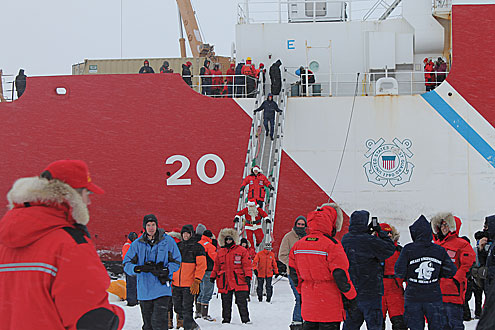By Katlin Bowman, Postdoctoral Research Scholar, UCSC Ocean Sciences Department

Everyone had a chance to take pictures with Santa at the North Pole (See photo #3), some of the Coast Guard crew members hand delivered letters to Santa from their children. During the summer Arctic temperatures were around 10-20 degrees Fahrenheit but could feel like -10 with the wind chill.
This was only the fourth time in history that a U.S. surface ship has reached the North Pole, and this summer marked the first unaccompanied mission (previous journeys required a team of two ships to break through the ice). We did have to break through ice to get to the North Pole, but we had trouble finding ice sheets large enough to sample throughout the cruise. Our plan was to sample ten ice stations but we were only able to do six because the ice was so thin. The expedition was funded by the U.S. National Science Foundation as part of the international GEOTRACES program (geotraces.org), a multi-nation effort to understand the chemistry of the world ocean.
Temperatures in the Arctic are increasing faster than rest of the world – when sea ice and snow melt, the ocean absorbs heat rather than reflecting solar radiation, which amplifies warming. Since 1979, sea ice cover in the Arctic has been decreasing by 5% each decade, and at this rate scientists predict that the Arctic Ocean will be ice free in the summer within the next 25 years.
To establish this baseline, teams from the United States, Canada, and Germany
completed cruise transects in different parts of the Arctic Ocean this summer, with overlapping stations that will allow researchers to compare the quality of their results. Seawater, snow, ice, phytoplankton, aerosol dust, and deep ocean sediment were collected and analyzed for dozens of different elements including contaminants like lead and mercury, micronutrients such as iron and cobalt, and radiogenic tracers that will help determine the age and flow pattern of different water masses. Many elements measured on these expeditions have never been examined in this part of the world and the entire dataset will take 2–3 years to complete.
For more information on this expedition, life at sea, and working in the open ocean check out hginthesea.wordpress.com and huffingtonpost.com/Katlin-bowman.